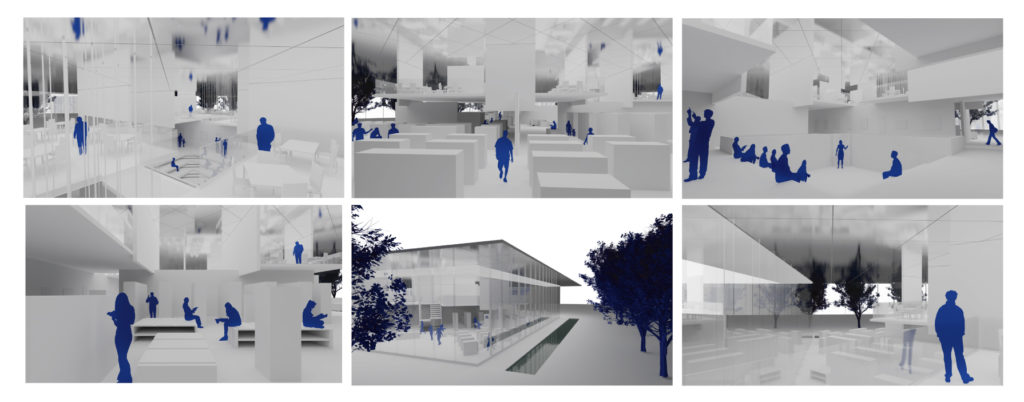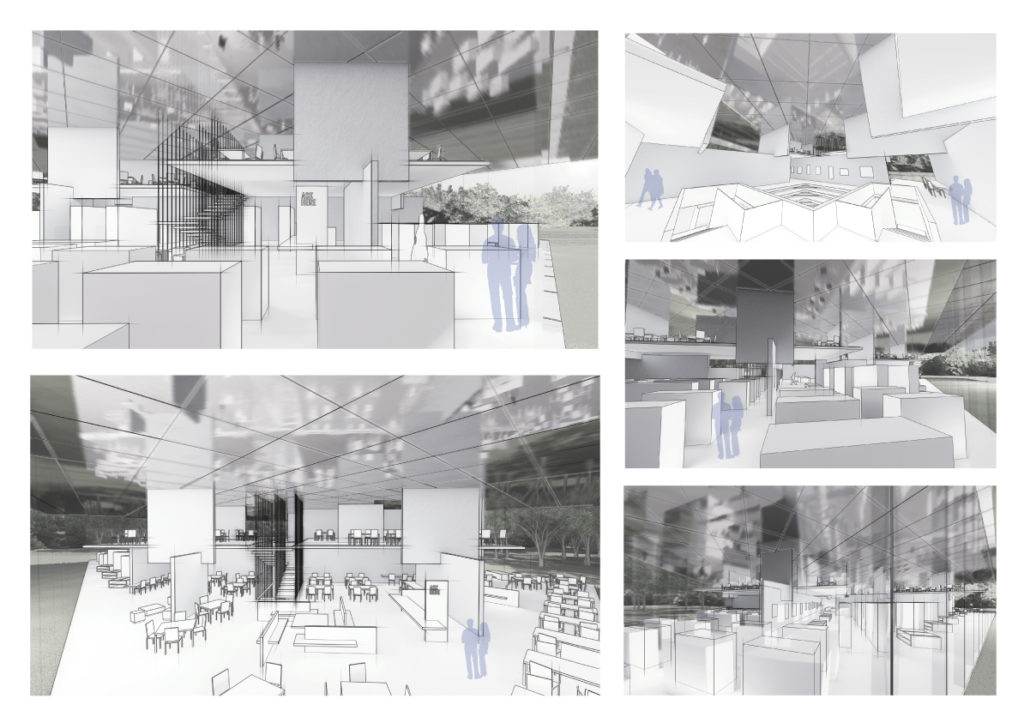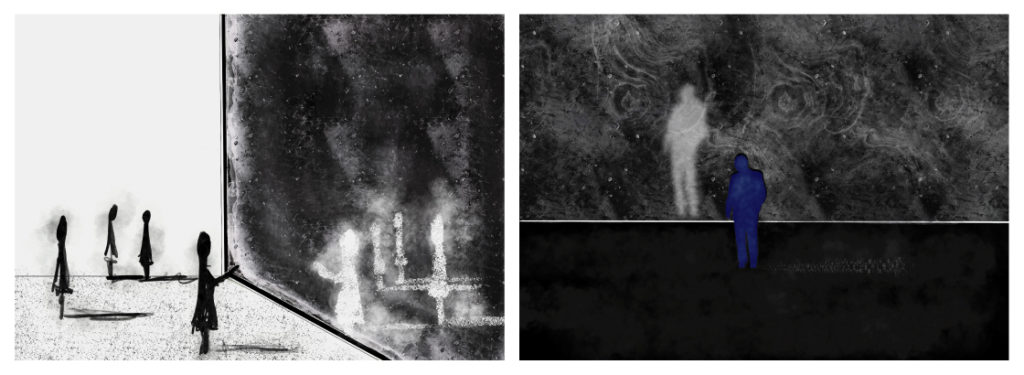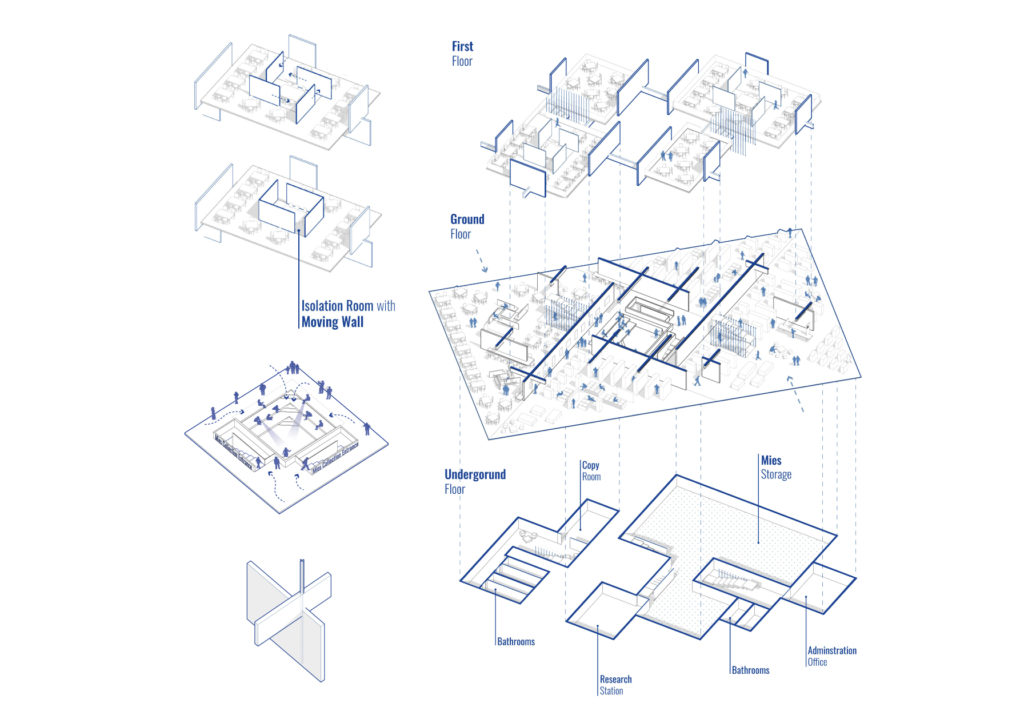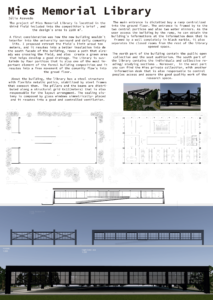-Miesperience-
If a memorial library is going to be designed for Mies and architecture students will use it, the important factors for us were to provide interaction, experience and inspiration. We tried to make a design where students could experience Mies’ thoughts, learn from each other in interaction, and be inspired by the ambient atmosphere while doing this. For this, we created a fiction of spaces and planes that depicts Mies’ mind. Not only that, but by using the upper plane, we got the reflection of the deformed, changed and renewed state of this mental world. In our opinion, this is the potential reflection of Mies’ ideas today. In addition, we believe that there is a need for special study environments in which students can focus, as well as environments where they are motivated by seeing each other. Based on this, the plan circulation focuses on the middle of the four main walls, which are placed diagonally in parallel with the entrance axis. These walls form a Mies Exhibition Path. There are no clear boundaries between working environments. Vertical planes are also effective in breaking the sound transition between spaces and hide them in the carrier system. However, areas that are more private or need to be protected have been taken underground in order not to disrupt the above experience.
Reflection of Mies’s mind
Understanding Mies’ mind and experiencing him as an architecture student can be a source of inspiration for students. So you can experience Mies’ relationship between spaces and planes in the library, but is that really enough to understand Mies’ mind? Mies has always adopted an understanding that focuses on the present and is open to continuous renewal and change. Therefore, Mies planes pass into a different dimension for us at this point. The ceiling of the library consists entirely of reflective surfaces and deforms the Mies world we observe below, dragging us into a more uncertain and renewed world. This is like the present reflection of Mies’ mind because we know that he will always change his understanding according to the conditions of the time he is in. In this context, we aim to encourage students to think and question this atmosphere. We think Mies used to teach this to his students, not to reminisce about the past, but to present innovations and necessities.
1.Exterior
1.1.Relationship with campus
Mies’ works can be found at many points on the campus. At this situation, we thought about what the prerequisites of a new design should be. In line with our conclusion, we came up with a design that is compatible with its surroundings, reminiscent of Mies, but breaks it within itself.
1.2 Master plan
We think that the area we chose is an important circulation point for students. We chose this area because of its strong relationship with the faculty of architecture and the main street, and we positioned the entrances and exits according to these two axes. We planned that the library would be a focal point for users. This building is not only a library, but also an area of experience where they can draw inspiration, at this point we decided to have Mies Collection at the intersection of important axes, that is, in the center.
2.Interior
2.1. Connection with the environment and sunlight
When we examined Mies, we saw that he argued that only a whole design with the environment can create a qualified space element. New dimensions opened by sunlight, green tones and reflections! For us, one of the best ways to commemorate mies is to experience his ideal space, which is why we designed a library with glass facades. We thought of a place that would come alive with the swaying of the leaves of the surrounding trees in the wind. We wanted to create a completely different environment with the reflections that will occur when the sunlight is refracted as it enters through the glass and hit the mirror on the ceiling, so we planned to keep mies’ relationship of emptiness and fullness alive. Thanks to the mirror, the distances will be twice as long as they can be seen, and the light factor will be doubled at the same time, so that the illumination of the spaces will be provided at a certain rate depending on the movement of the sun.
2.2. Learn by experience
The importance Mies places on the architecture curriculum has been another focus of ours. Based on this, we designed open-plan spaces where students can learn by experience. The movable walls we have placed at some points of the library will be under the control of the students and will allow them to create their own private spaces. In this way, students will be able to better understand the perception of space and create their own environments in different variations. This is how we thought it was important for an architecture student to experience a space.
2.3 Creating a new culture
We decided to consider the roof of the building as a green roof. Our starting point in this regard was the meaning that the formation of the green roof culture in Chicago gave us. We know that Mies has always focused on the present. We also researched today’s world and today’s architecture. Global warming threatens the world. In this period, we think that we, as candidate architects, should do our best. While doing this, being a part of the green roof culture of Chicago architecture is another source of motivation for us.

